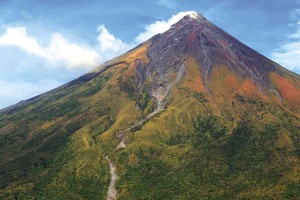Mayon Volcano restive; Alert Level 3 raised
LEGAZPI CITY, Philippines–About 20 families living within the six-kilometer permanent danger zone in Guinobatan, Albay were evacuated Monday night after the Philippine Institute of Volcanology and Seismology (Phivolcs) raised alert level 3 over Mayon Volcano.
Resident volcanologist Eduardo Laguerta at the Phivolcs observatory in Lignon Hill here said the alert level was raised at 10 p.m. Monday night after they had noted “a noticeable escalation of unrest.”
He said they had recorded 39 rockfall events and 32 volcanic quakes from 5 a.m. to 8 p.m. on Monday.
Crater glow was observed with incandescent materials flowing on the slope.
Phivolcs said it traced the rock falls to “incipient breaching of the growing summit lava dome” in the volcano’s southeastern crater rim. The volcanic quakes, it said, indicated “magma intrusion and/or volcanic gas activity.”
“Crater glow has become observable, indicating incandescence of the crater from molten lava and hot volcanic gas,” Phivolcs also said.
Alert Level 3 means that Mayon “is exhibiting relatively high unrest and that magma is at the crater,” it said, adding that “hazardous eruption is possible within weeks.”
Phivolcs advised authorities to enforce the 6-kilometer radius Permanent Danger Zone (PDZ) around the volcano and the 7-km Extended Danger Zone (EDZ) on the southeastern flank due to the danger of “rock falls, landslides and sudden explosions or dome collapse that may generate hazardous volcanic flows.”
Mayon and its surroundings are also a popular tourist destination.
Mayon, one of the Philippines’ most active volcanoes, last erupted in May 2013 when it spewed a giant ash cloud and a hail of rocks, killing four foreign tourists and their local tour guide.
The 2,460-meter (8,070-foot) Mayon is famed for its near-perfect cone but has a long history of deadly eruptions.
In 1814, more than 1,200 people were killed when lava flows buried the town of Cagsawa.
An explosion in August 2006 did not cause direct deaths, but the following December a passing typhoon unleashed an avalanche of volcanic mud from Mayon’s slopes that killed 1,000 people. —With Rick Alberto, INQUIRER.net and Agence France-Presse
RELATED STORY
12,000 evacuated amid increasing Mayon rockfall, quakes
Originally posted: 8:43 am | Tuesday, September 16th, 2014
